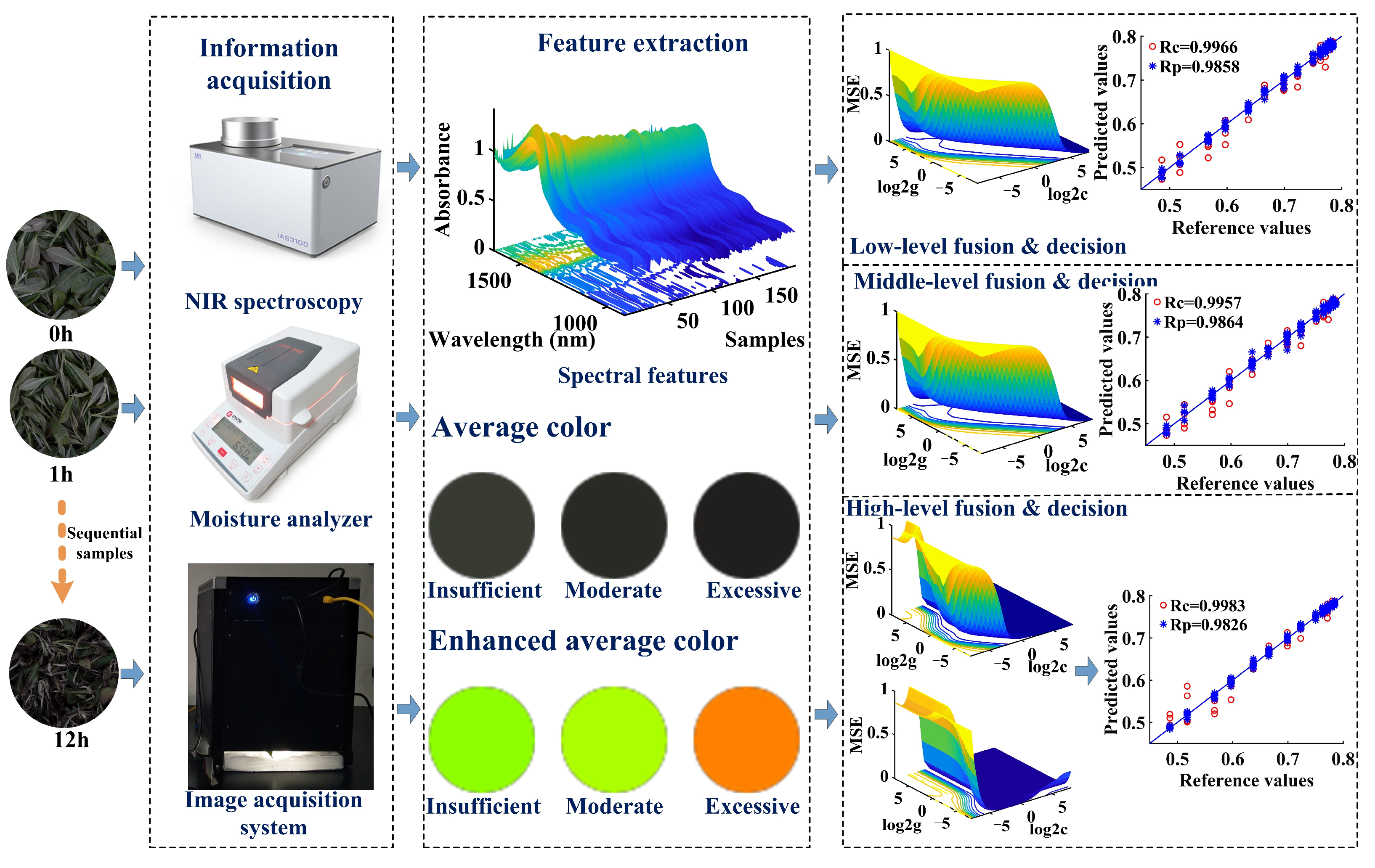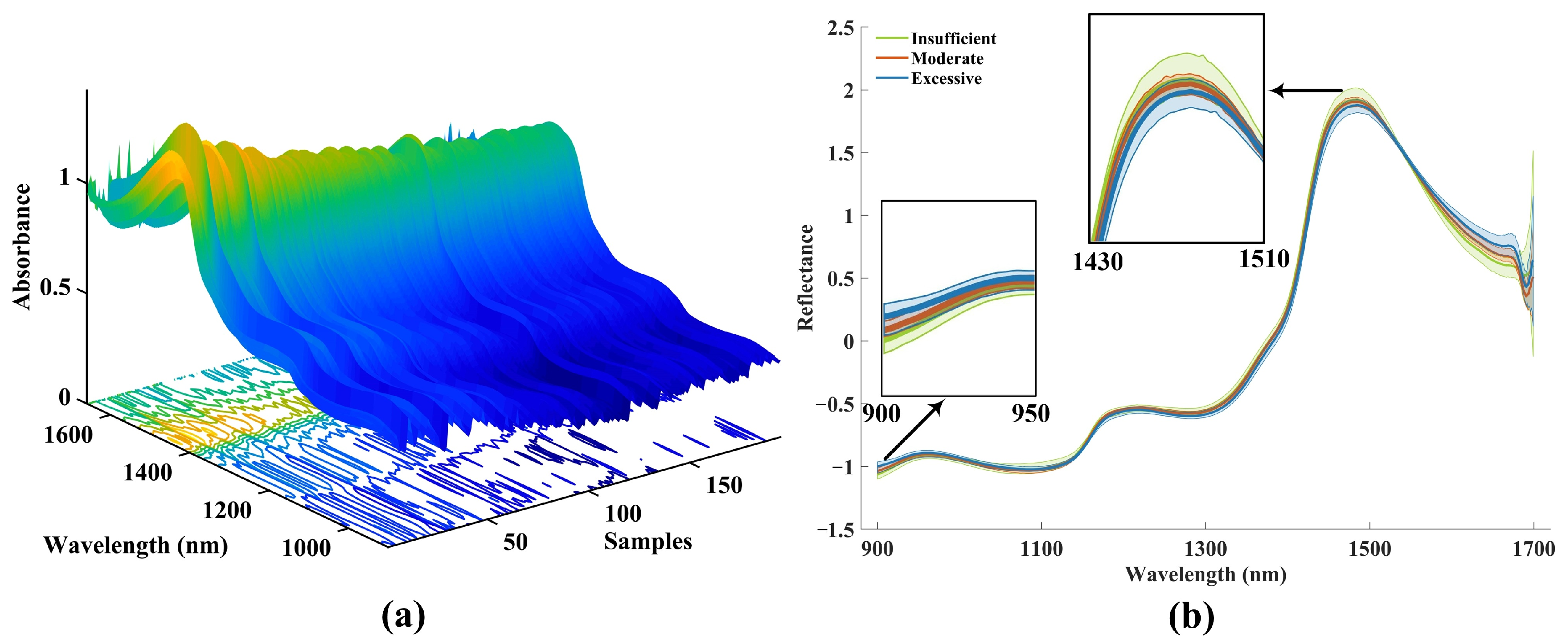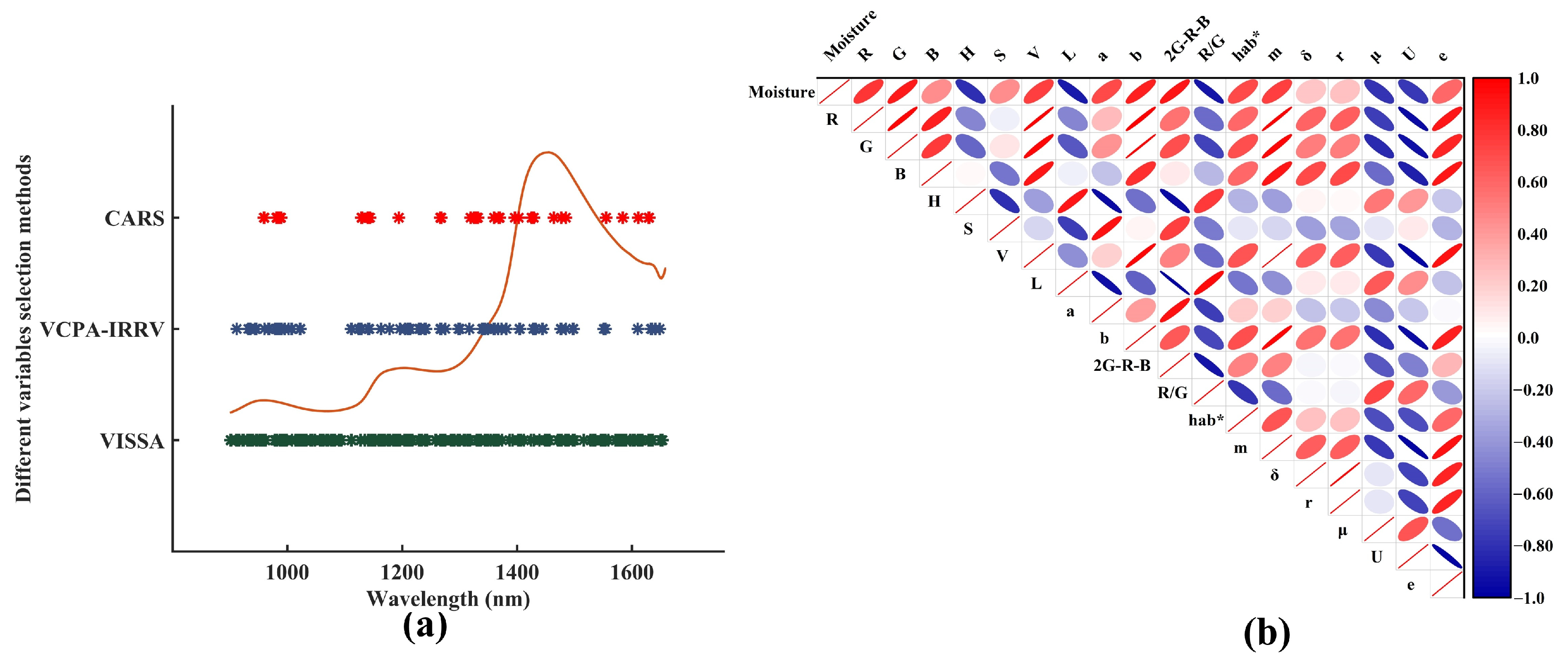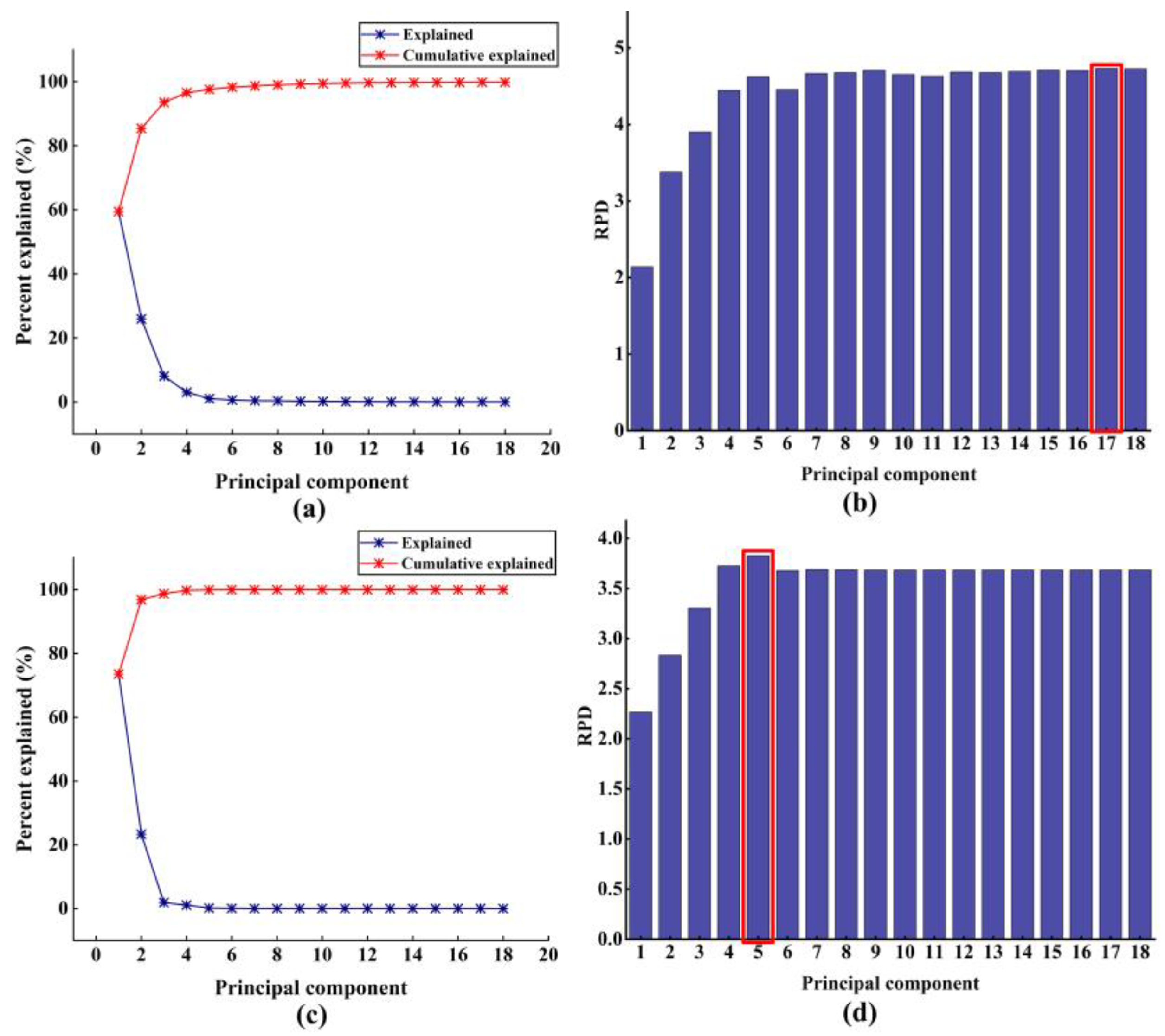Evaluation of Withering Quality of Black Tea Based on Multi-Information Fusion Strategy
Abstract
1. Introduction
2. Materials and Methods
2.1. Samples
2.2. Spectra Acquisition by NIRS
2.3. Image Acquisition by Self-Built MV System
2.4. Data Fusion Strategy
2.5. Moisture Perception Model Establishment and Evaluation
2.6. Software
3. Results and Discussion
3.1. Digital Information Representation and Analysis of Different Sensors
3.1.1. Internal Features of Withering Leaves
3.1.2. External Features of Withering Leaves
3.2. Effective Feature Selection of Different Digital Information
3.2.1. Feature Selection of Spectral Information
3.2.2. Feature Selection of Image Information
3.3. Moisture Prediction Models with a Single Technology
3.4. Moisture Perception Models with Multi-Level Data Fusion
3.4.1. Low-Level Fusion Strategy
3.4.2. Middle-Level-PCA Fusion Strategy
3.4.3. Middle-Level-Variable Selection Fusion Strategy
3.4.4. High-Level Fusion Strategy
3.5. Model Comparison and Evaluation
4. Conclusions
- (1)
- This study proved the feasibility of the perception of the MC values in withering leaves based on the NIRS combined with MV technology. The multi-information fusion strategy overcomes the limitations of single digital information that can only capture partial feature information, providing a novel methodology for the comprehensive characterization of tea samples.
- (2)
- NIRS technology demonstrates superior moisture detection capability compared with MV technology. This discovery provides valuable insights into refining fusion information models and developing specialized equipment in subsequent research.
- (3)
- An appropriate data fusion strategy could remove redundant features and improve the accuracy of the moisture prediction model for withering leaves. The middle-level-VISSA strategy achieves the most accurate moisture perception. The selection of multi-information fusion strategies is critically important for accurate perception and precise control of moisture content during withering processing.
Author Contributions
Funding
Institutional Review Board Statement
Informed Consent Statement
Data Availability Statement
Conflicts of Interest
References
- Richelle, M.; Tavazzi, I.; Offord, E.; Chemistry, F. Comparison of the Antioxidant Activity of Commonly Consumed Polyphenolic Beverages (Coffee, Cocoa, and Tea) Prepared per Cup Serving. J. Agric. Food Chem. 2001, 49, 3438–3442. [Google Scholar] [CrossRef] [PubMed]
- Qiao, M.; Xu, Y.; Xia, G.; Su, Y.; Lu, B.; Gao, X.; Fan, H. Determination of hardness for maize kernels based on hyperspectral imaging. Food Chem. 2022, 366, 130559. [Google Scholar] [CrossRef] [PubMed]
- Tian, X.; Zhang, C.; Li, J.; Fan, S.; Yang, Y.; Huang, W. Detection of early decay on citrus using LW-NIR hyperspectral reflectance imaging coupled with two-band ratio and improved watershed segmentation algorithm. Food Chem. 2021, 360, 130077. [Google Scholar] [CrossRef]
- Li, J.; Zhang, R.; Li, J.; Wang, Z.; Zhang, H.; Zhan, B.; Jiang, Y. Detection of early decayed oranges based on multispectral principal component image combining both bi-dimensional empirical mode decomposition and watershed segmentation method. Postharvest Biol. Technol. 2019, 158, 110986. [Google Scholar] [CrossRef]
- Wei, Y.; Wu, F.; Xu, J.; Sha, J.; Zhao, Z.; He, Y.; Li, X. Visual detection of the moisture content of tea leaves with hyperspectral imaging technology. J. Food Eng. 2019, 248, 89–96. [Google Scholar] [CrossRef]
- Liang, G.; Dong, C.; Hu, B.; Zhu, H.; Yuan, H.; Jiang, Y.; Hao, G. Prediction of Moisture Content for Congou Black Tea Withering Leaves Using Image Features and Nonlinear Method. Sci. Rep. 2018, 8, 7854. [Google Scholar] [CrossRef]
- An, T.; Yu, H.; Yang, C.; Liang, G.; Dong, C. Black tea withering moisture detection method based on convolution neural network confidence. J. Food Process Eng. 2020, 43, e13428. [Google Scholar] [CrossRef]
- Huang, Z.X.; Sanaeifar, A.; Tian, Y.; Liu, L.; Zhang, D.Y.; Wang, H.; Ye, D.P.; Li, X.L. Improved generalization of spectral models associated with Vis-NIR spectroscopy for determining the moisture content of different tea leaves. J. Food Eng. 2021, 293, 110374. [Google Scholar] [CrossRef]
- Zhang, S.; Zuo, Y.; Wu, Q.; Wang, J.; Ban, L.; Yang, H.; Bai, Z. Development and Validation of Near-Infrared Methods for the Quantitation of Caffeine, Epigallocatechin-3-gallate, and Moisture in Green Tea Production. J. Anal. Methods Chem. 2021, 2021, 9563162. [Google Scholar] [CrossRef]
- An, T.; Yu, S.; Huang, W.; Li, G.; Tian, X.; Fan, S.; Dong, C.; Zhao, C. Robustness and accuracy evaluation of moisture prediction model for black tea withering process using hyperspectral imaging. Spectrochim. Acta A Mol. Biomol. Spectrosc. 2022, 269, 120791. [Google Scholar] [CrossRef]
- Wei, Y.Z.; He, Y.; Li, X.L. Tea moisture content detection with multispectral and depth images. Comput. Electron. Agric. 2021, 183, 106082. [Google Scholar] [CrossRef]
- Wang, Y.; Liu, Y.; Cui, Q.; Li, L.; Ning, J.; Zhang, Z. Monitoring the withering condition of leaves during black tea processing via the fusion of electronic eye (E-eye), colorimetric sensing array (CSA), and micro-near-infrared spectroscopy (NIRS). J. Food Eng. 2021, 300, 110534. [Google Scholar] [CrossRef]
- Chen, J.; Yang, C.; Yuan, C.; Li, Y.; An, T.; Dong, C. Moisture content monitoring in withering leaves during black tea processing based on electronic eye and near infrared spectroscopy. Sci. Rep. 2022, 12, 20721. [Google Scholar] [CrossRef] [PubMed]
- Zhu, J.; Fan, X.; Han, L.; Zhang, C.; Wang, J.; Pan, L.; Tu, K.; Peng, J.; Zhang, M. Quantitative analysis of caprolactam in sauce-based food using infrared spectroscopy combined with data fusion strategies. J. Food Compos. Anal. 2021, 104, 104130. [Google Scholar] [CrossRef]
- Gewers, F.L.; Ferreira, G.R.; Arruda, H.F.; Silva, F.N.; Comin, C.H.; Amancio, D.R.; Costa, L.D. Principal Component Analysis: A Natural Approach to Data Exploration. ACM Comput. Surv. 2021, 54, 1–34. [Google Scholar] [CrossRef]
- Deng, B.-C.; Yun, Y.-H.; Liang, Y.-Z.; Yi, L.-Z. A novel variable selection approach that iteratively optimizes variable space using weighted binary matrix sampling. Analyst 2014, 139, 4836–4845. [Google Scholar] [CrossRef]
- Li, J.; Chen, L. Comparative analysis of models for robust and accurate evaluation of soluble solids content in ‘Pinggu’ peaches by hyperspectral imaging. Comput. Electron. Agric. 2017, 142, 524–535. [Google Scholar] [CrossRef]
- Wang, Y.; Li, L.; Liu, Y.; Cui, Q.; Ning, J.; Zhang, Z. Enhanced quality monitoring during black tea processing by the fusion of NIRS and computer vision. J. Food Eng. 2021, 304, 110599. [Google Scholar] [CrossRef]
- Ye, J.Y.; Yang, Z.X.; Li, Z.L. Quadratic hyper-surface kernel-free least squares support vector regression. Intell. Data Anal. 2021, 25, 265–281. [Google Scholar] [CrossRef]
- Wang, Y.-J.; Li, T.-H.; Li, L.-Q.; Ning, J.-M.; Zhang, Z.-Z. Evaluating taste-related attributes of black tea by micro-NIRS. J. Food Eng. 2021, 290, 110181. [Google Scholar] [CrossRef]
- Lee, M.-S.; Hwang, Y.-S.; Lee, J.; Choung, M.-G. The characterization of caffeine and nine individual catechins in the leaves of green tea (Camellia sinensis L.) by near-infrared reflectance spectroscopy. Food Chem. 2014, 158, 351–357. [Google Scholar] [CrossRef] [PubMed]
- Chen, Q.; Chen, M.; Liu, Y.; Wu, J.; Wang, X.; Ouyang, Q.; Chen, X. Application of FT-NIR spectroscopy for simultaneous estimation of taste quality and taste-related compounds content of black tea. J. Food Sci. Technol. Mysore 2018, 55, 4363–4368. [Google Scholar] [CrossRef] [PubMed]
- He, X.; Feng, X.; Sun, D.; Liu, F.; Bao, Y.; He, Y. Rapid and Nondestructive Measurement of Rice Seed Vitality of Different Years Using Near-Infrared Hyperspectral Imaging. Molecules 2019, 24, 2227. [Google Scholar] [CrossRef] [PubMed]
- Bokuchava, M.A.; Skobeleva, N.I. The biochemistry and technology of tea manufacture. Crit. Rev. Food Sci. Nutr. 1980, 12, 303–370. [Google Scholar] [CrossRef]
- Chun, J.U. Rapid Measure of Color and Catechins Contents in Processed Teas Using NIRS. Korean J. Plant Resour. 2010, 23, 386–392. [Google Scholar]
- Jiang, H.; Yu, F.; Qin, L.I.; Zhang, N.A.; Cao, Q.; Schwab, W.; Daxiang, L.; Song, C. Dynamic change in amino acids, catechins, alkaloids, and gallic acid in six types of tea processed from the same batch of fresh tea (Camellia sinensis L.) leaves. J. Food Compos. Anal. 2019, 77, 28–38. [Google Scholar] [CrossRef]
- Zhang, M.; Guo, J.; Ma, C.; Qiu, G.; Ren, J.; Zeng, F.; Lü, E. An effective prediction approach for moisture content of tea leaves based on discrete wavelet transforms and bootstraps of shrinkage algorithm. Appl. Sci. 2020, 10, 4839. [Google Scholar] [CrossRef]




| Data | No. of Variables | Parameter | Calibration Sets | Prediction Sets | ||||
|---|---|---|---|---|---|---|---|---|
| c | g | Rc | RMSEC | Rp | RMSEP | RPD | ||
| NIR | 760 | 0.4353 | 1.3195 | 0.9971 | 0.0078 | 0.9775 | 0.0210 | 4.7258 |
| MV | 18 | 0.4353 | 0.0206 | 0.9958 | 0.0094 | 0.9657 | 0.0260 | 3.6824 |
| Level | Methods | No. of Variables | Parameter | Calibration Sets | Prediction Sets | ||||
|---|---|---|---|---|---|---|---|---|---|
| c | g | Rc | RMSEC | Rp | RMSEP | RPD | |||
| Low-level | 778 | 3.0314 | 256 | 0.9966 | 0.0082 | 0.9858 | 0.0180 | 5.6142 | |
| Middle-level | PCA | 22 | 0.7579 | 0.0156 | 0.9964 | 0.0086 | 0.9669 | 0.0260 | 3.7149 |
| CARS | 55 | 0.5743 | 256 | 0.9922 | 0.0125 | 0.9854 | 0.0193 | 5.2756 | |
| VCPA-IRIV | 100 | 1 | 256 | 0.9932 | 0.0116 | 0.9859 | 0.0188 | 5.4320 | |
| VISSA | 245 | 5.2780 | 256 | 0.9957 | 0.0092 | 0.9864 | 0.0178 | 5.7705 | |
| High-level | MLR | 0.9883 | 0.0057 | 0.9826 | 0.0186 | 5.3456 | |||
Disclaimer/Publisher’s Note: The statements, opinions and data contained in all publications are solely those of the individual author(s) and contributor(s) and not of MDPI and/or the editor(s). MDPI and/or the editor(s) disclaim responsibility for any injury to people or property resulting from any ideas, methods, instructions or products referred to in the content. |
© 2025 by the authors. Licensee MDPI, Basel, Switzerland. This article is an open access article distributed under the terms and conditions of the Creative Commons Attribution (CC BY) license (https://creativecommons.org/licenses/by/4.0/).
Share and Cite
An, T.; Jiang, Y.; Zou, H.; Xuan, X.; Zhang, J.; Yuan, H. Evaluation of Withering Quality of Black Tea Based on Multi-Information Fusion Strategy. Foods 2025, 14, 1442. https://doi.org/10.3390/foods14091442
An T, Jiang Y, Zou H, Xuan X, Zhang J, Yuan H. Evaluation of Withering Quality of Black Tea Based on Multi-Information Fusion Strategy. Foods. 2025; 14(9):1442. https://doi.org/10.3390/foods14091442
Chicago/Turabian StyleAn, Ting, Yongwen Jiang, Hanting Zou, Xuan Xuan, Jian Zhang, and Haibo Yuan. 2025. "Evaluation of Withering Quality of Black Tea Based on Multi-Information Fusion Strategy" Foods 14, no. 9: 1442. https://doi.org/10.3390/foods14091442
APA StyleAn, T., Jiang, Y., Zou, H., Xuan, X., Zhang, J., & Yuan, H. (2025). Evaluation of Withering Quality of Black Tea Based on Multi-Information Fusion Strategy. Foods, 14(9), 1442. https://doi.org/10.3390/foods14091442






